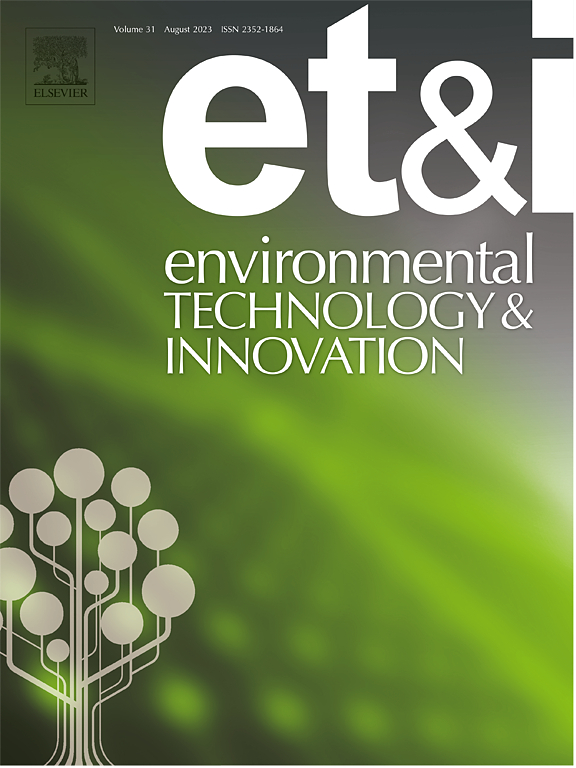Screening lentil genotypes for chromium resilience: A study of growth characteristics, oxidative stress responses, and expression analysis
IF 7.1
2区 环境科学与生态学
Q1 BIOTECHNOLOGY & APPLIED MICROBIOLOGY
引用次数: 0
Abstract
Plants face environmental challenges from the deposition of heavy metals in soil that hinder growth and compromise yield. Despite the significant losses caused by chromium (Cr) stress, the development of efficient screening methods, as well as the identification of tolerant lentil germplasm and resistance genes remains inadequate. To tackle this, we screened 200 lentil genotypes for Cr tolerance at the seedling stage using a completely randomized block design with three replications under hydroponic condition. The results showed significant genetic diversity among the genotypes, with reductions in morphological traits under Cr stress ranging from 5.66 % for relative water (RW) content to 58.14 % for fresh shoot (FS) weight compared to controls. Principal component analysis identified four key traits contributing to stress tolerance: fresh shoot (FS) weight (0.0657 g), dry shoot (DS) weight (0.0084 g), shoot length (SL) (8.9315 cm), and dry root (DR) weight (0.0084 g). These traits were positively correlated with each other and can serve as selection criteria for identifying elite tolerant genotypes. Genotypes were clustered into four groups, and five Cr-tolerant genotypes were selected based on a stress tolerance index (STI) value of > 0.65 for all studied traits. These selected genotypes exhibited efficient antioxidant activities, indicating inherent defense mechanisms. Antioxidant enzyme levels increased significantly, except for ascorbate peroxidase (APX), which decreased compared to controls. Under Cr stress, osmolyte and antioxidant enzyme accumulation increased, while total protein and flavonoid content decreased. Cr toxicity is believed to induce oxidative damage, as evidenced by elevated antioxidant enzyme levels and reduced photosynthetic pigments. RNA-seq data analysis revealed five Cr stress tolerance genes, which were further validated through RT-qPCR. These findings suggest that the five genotypes identified could serve as potential lines for developing Cr-tolerant lentils. Additionally, the roles of five Cr stress tolerance genes warrant further investigation to better understand their functional mechanisms under Cr stress in lentils.
筛选小扁豆抗铬基因型:生长特性、氧化应激反应和表达分析的研究
植物面临着重金属在土壤中沉积的环境挑战,这些重金属会阻碍生长和降低产量。尽管铬胁迫对小扁豆造成了重大损失,但有效筛选方法的开发以及抗性基因和抗性种质的鉴定仍然不足。为了解决这一问题,在水培条件下,采用完全随机区组设计,筛选了200个小扁豆苗期耐铬基因型。结果表明,各基因型间存在显著的遗传多样性,Cr胁迫下的形态性状与对照相比,相对水分含量(RW)降低5.66 %,鲜梢重(FS)降低58.14 %。主成分分析鉴定出4个对抗逆性有影响的关键性状:鲜梢重(0.0657 g)、干梢重(0.0084 g)、茎长(8.9315 cm)和干根重(0.0084 g)。这些性状之间存在正相关关系,可作为鉴定优质耐受性基因型的选择标准。将基因型聚类为4组,根据所有性状的胁迫耐受性指数(STI)为>; 0.65,筛选出5个耐cr基因型。这些选择的基因型表现出有效的抗氧化活性,表明内在的防御机制。除抗坏血酸过氧化物酶(APX)低于对照组外,抗氧化酶水平显著升高。Cr胁迫下,渗透酶和抗氧化酶积累增加,总蛋白和类黄酮含量降低。铬中毒被认为会引起氧化损伤,这可以通过抗氧化酶水平升高和光合色素减少来证明。RNA-seq数据分析发现5个Cr胁迫耐受基因,并通过RT-qPCR进一步验证。这些发现表明,鉴定的5种基因型可以作为培育耐铬小扁豆的潜在品系。此外,还需要进一步研究5个Cr胁迫耐受基因的作用,以更好地了解它们在Cr胁迫下的功能机制。
本文章由计算机程序翻译,如有差异,请以英文原文为准。
求助全文
约1分钟内获得全文
求助全文
来源期刊

Environmental Technology & Innovation
Environmental Science-General Environmental Science
CiteScore
14.00
自引率
4.20%
发文量
435
审稿时长
74 days
期刊介绍:
Environmental Technology & Innovation adopts a challenge-oriented approach to solutions by integrating natural sciences to promote a sustainable future. The journal aims to foster the creation and development of innovative products, technologies, and ideas that enhance the environment, with impacts across soil, air, water, and food in rural and urban areas.
As a platform for disseminating scientific evidence for environmental protection and sustainable development, the journal emphasizes fundamental science, methodologies, tools, techniques, and policy considerations. It emphasizes the importance of science and technology in environmental benefits, including smarter, cleaner technologies for environmental protection, more efficient resource processing methods, and the evidence supporting their effectiveness.
 求助内容:
求助内容: 应助结果提醒方式:
应助结果提醒方式:


